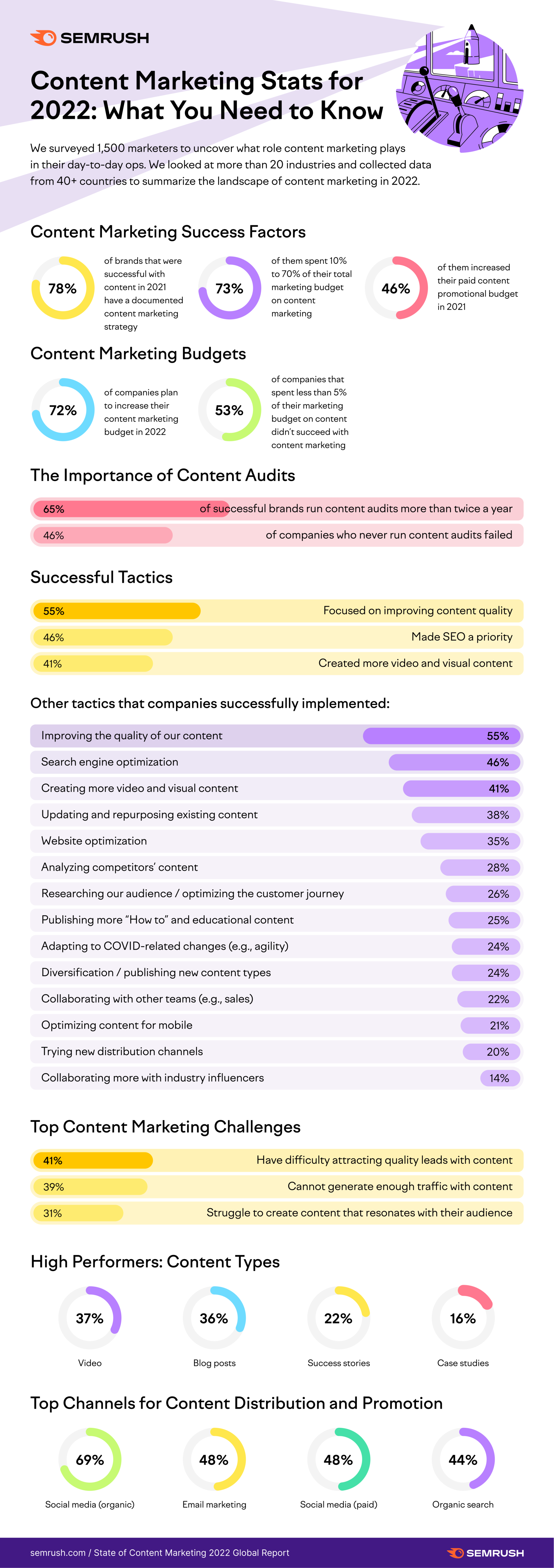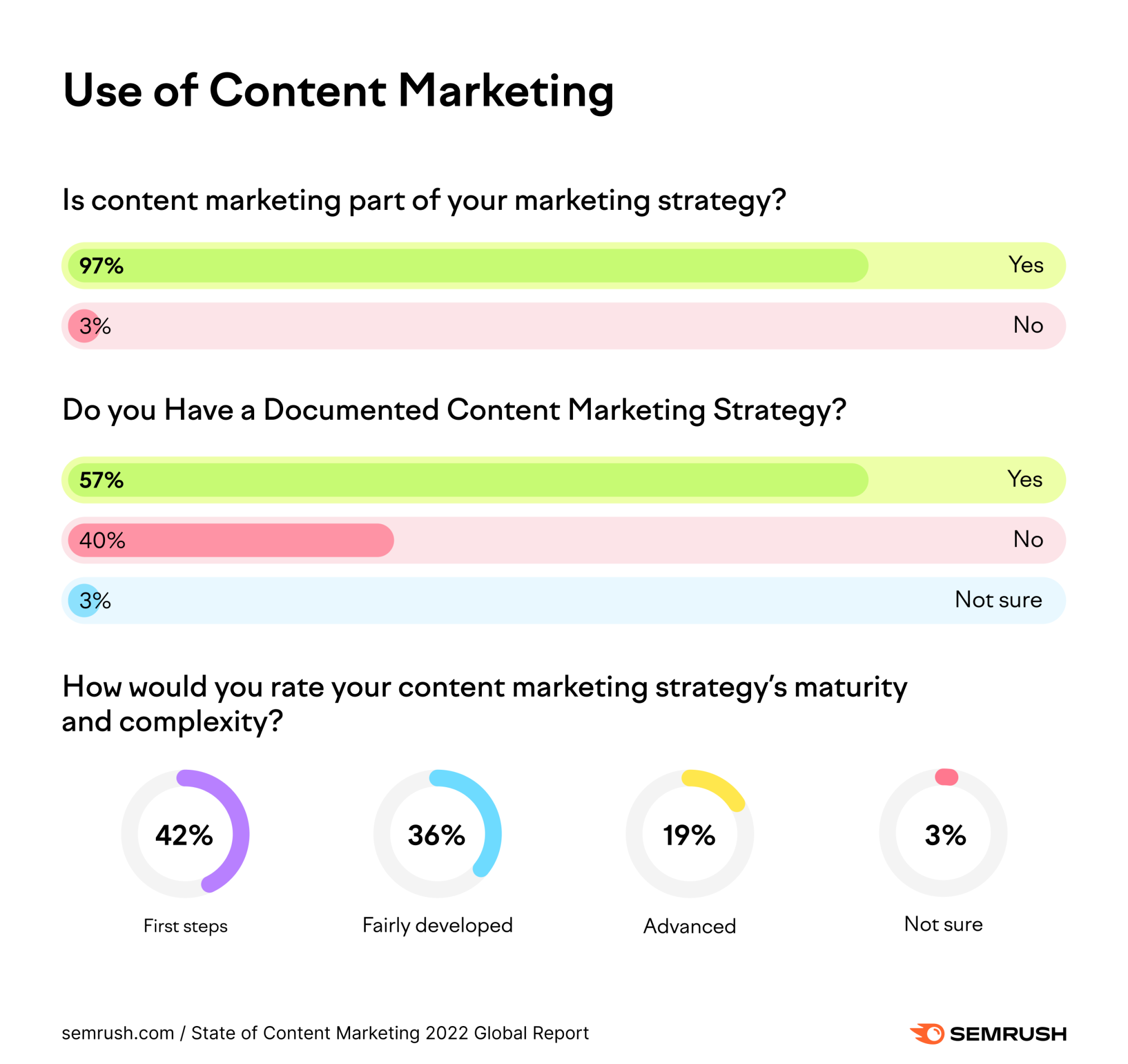Your company’s manufacturing supply chain involves everything it takes to turn raw materials into usable items, sell the finished products, and distribute them to the buyers. Similarly, your content supply chain includes all the sources, plans, and activities it takes to turn ideas into valuable content and distribute it to your target audience.
In today’s digital universe, the content your marketing teams produce is every bit as critical to your company’s success as the products and services you produce.
Here’s why. Your content is the foundation of trust you must build before a prospect becomes a customer. Your products won’t see the light of day unless your content can push them into the hands of paying customers.
Let’s take a look at the critical steps in your content supply chain:
Document Your Content Strategy
As the ancient warrior Sun Tzu warned, “Tactics without strategy is the noise before defeat.”
Research has proven this advice sound, even when it comes to content marketing. A recent Semrush study found a direct link between having a documented content strategy and success. Seventy-eight percent of businesses that document their strategy experience success, the study found.
Image via Semrush
But even in 2022, 40 percent of marketers don’t yet document their content strategy, Semrush discovered. Three percent don’t even know if they even have a documented strategy.
Image via Semrush
- Set your brand guidelines in stone: Be sure to include your brand guidelines in your content strategy documentation. These precepts define your brand’s distinctive voice, tone, and personality. Include your brand’s focus keywords in the mix so that your teams can include them in the content and meta tags. Be sure to document any compliance or legal requirements content teams need to follow. It will save you time and hassle during the approval process.
- Align your content objectives with your corporate goals: Make sure your content strategy aligns with your C-suite’s goals. Then, communicate those goals to your teams in your content strategy documentation. When everyone is on the same page, you’re well on your way to achieving those goals.
- List your buyer personas: Research your target market and define who they are – demographics, income level, pain points, and interests.
- Define your customer journey: As with most destinations, the buyer’s journey often takes many roads to get there. Including a customer journey map in your strategy documentation allows your creatives to target various stages in the customer journey with pertinent content. Then, define the objectives you want to reach at each stage so you can measure whether your content achieves its goals.
- Include metadata: As Deloitte’s Michael Vovk puts it, metadata is “the underlying enabler” for content teams. Using an out-the-box metadata management system allows you to preload information onto your calendar, making your creative teams’ lives easier – and allowing you to track content topics that resonate with your audience.
- Have an easily accessible asset management system in place: Your content metadata can also help your teams track down past content they need to reference in new work. Similarly, organizing your image asset library so your teams can find the latest versions of graphs, infographics, or images quickly can save time and money. You don’t need to pay for new images when you have the perfect one already in your library.
- Document your content workflow: A key ingredient in content operations and governance is clear communication about your expectations. New employees and those you outsource through agencies need to know what steps they need to follow during the content planning, creation, and distribution process. Including your content workflow in your strategy document will give them the guidance they need.
Plan Content to Achieve Your Objectives
Use your customer personas’ pain points, comments on social media, and information you glean from collaboration with sales and support to research topics that would interest your prospects and help them move along toward your objectives.
Then, use your content calendar to schedule publication when your target audience is likely to be online.
Assign Production Tasks to Your Team
Once the plan’s in place, choose the teams whose interests and expertise align with the content you’ve planned. For example, if your target audience prefers videos to receive information, you need to assign content for them to your video team.
Or, you might have a blog writer on your staff that has a knack for copy that captivates your readers, but the topic you want to assign her is highly technical. So, you might want to line up a content collaboration session with your company’s head of engineering so that your writer can wrap her head around the topic.
Route All Content Through Your Editorial, Compliance, and Legal Teams
Typos happen. So does cringeworthy content. We’ve all had our facepalm moments.
That’s why your editorial teams are your creative teams’ best friends. No matter how accurate your writers’ grammar, spelling, and research skills are, there’s nothing like a fresh pair of eyes and ears to catch a faux pas before you press “Publish.”
While companies differ in the legal and compliance requirements their content must meet, it always is prudent to run most content by your company’s compliance and legal departments before publication.
Make the approval process go easier by keeping the channels of communication open between your creatives, editors, legal, and compliance teams. When your creative teams have an open line to those departments during the content creation process, it can speed up approvals considerably.
Amplify Your Content’s Reach
With a robust content automation process, you can turn over most of these tasks to your non-human contingent. When you’ve already specified which channels you want your content to live in your content metadata, your teams can publish the content on those channels with the touch of a button.
Analyze Your Content’s Performance
As David Edelman puts it, “One of the big differences between a content supply chain and a product supply chain is that the content supply chain is not linear; it’s constantly refreshing itself.”
Part of that refreshing is the changes you’ll make to tweak its performance. Use your content analytics to identify your poorly performing content relative to your key metrics.
Then, review the content to see where it’s falling short of your goals and revise it to perform to its full potential. Keep testing and “refreshing” until you achieve your original objective.
Repurpose Older Content to Give It New Life
If your company is like most larger corporations, you probably have a wealth of content assets in your library. If it’s still performing well with its target audience, let it work its magic with new audiences in a different form. Here are some ideas:
- Expand several blog posts into an ebook.
- Transform an online user manual into a how-to video.
- Use your product brochure as the springboard for an explainer video.
- Turn customer testimonial videos into case studies.
- Turn data from a white paper into an infographic.
When it comes to repurposing content, you and your teams’ imagination is the only limit. Make the most of your content investment by giving it new life.
To put your content supply chain into warp drive, having a content marketing platform that can organize all the processes and resources involved is critical to achieving success.
With out-of-the-box content metadata management, customized performance analytics, and a calendar that’s designed specifically for content and editorial planning across the enterprise – and so much more, DivvyHQ is up to the task. Even better, it’s yours to try for 14 days, absolutely free. Start your free trial today!

